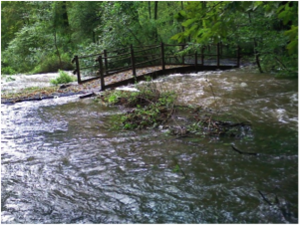Flood Plains

Related Brandwein Outdoor Learning Activities
You might want to record the level of the creek and the extent of the flood plain on your first visit and then return during another season to see how the water has changed over time. Recording your discoveries digitally will focus attention to small details that are otherwise easy to overlook. The digital record can also be used as a future reference back in the classroom, providing an easy way to capture images relevant to the curriculum.
Students often believe that all science observations must be quantitative. But there is ample room in science for qualitative observations. This activity encourages students who tend to be more right-brained, aesthetic or artistic to take ownership of the observation process. It ends with a discussion of how judgments are formed about the environment. See the activity “Caught You: Using Digital Cameras to Investigate Science.”
Pure water (H20) almost never exists in nature. Even raindrops that condense in clouds are filled with dust and bacteria. By the time water enters a lake or stream, it is filled with other chemicals, gasses, and organisms of all kinds. What makes water clean enough for animals (like fish) to live in? What makes it clean enough for humans to drink? Students can identify abiotic factors (like silt or chemicals) that affect the living things in a body of water. They can also get clues to the quality of water by the diversity and the types of species that are living in it. The most widely accepted definition of “health” in a body of water is its biodiversity. That’s normally associated with high levels of dissolved oxygen and the presence of a variety of organisms that need this high oxygen content. Pollutants like E. coli bacteria compete for oxygen, and create an aquatic environment in which only a few kinds of living things can survive. Using relatively simple techniques, students can get a sense of the biological health of a body of water. See the activity, “Water: Is It Clean Enough to Drink?”
